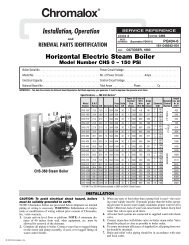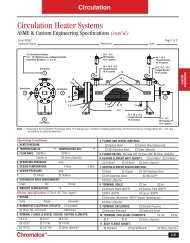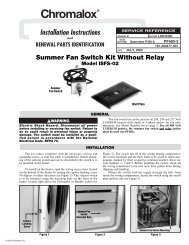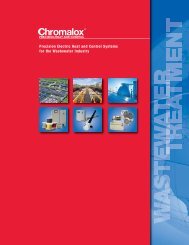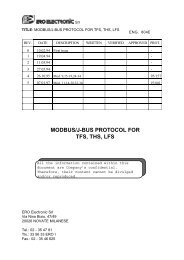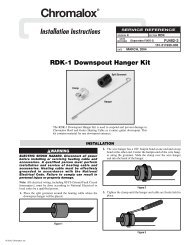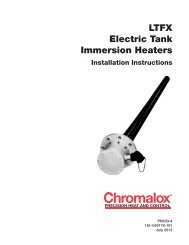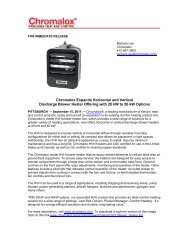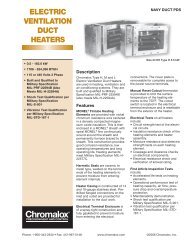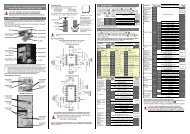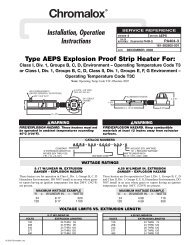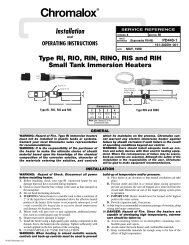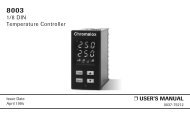Cold Weather Catalog - Chromalox Precision Heat and Control
Cold Weather Catalog - Chromalox Precision Heat and Control
Cold Weather Catalog - Chromalox Precision Heat and Control
- No tags were found...
Create successful ePaper yourself
Turn your PDF publications into a flip-book with our unique Google optimized e-Paper software.
TechnicalTechnical InformationThree Phase Equations & <strong>Heat</strong>er Wiring DiagramsOpen Delta & WyeR 2I LLI ThermostatLIVFused DisconnectPPSwitch ContactorR 2L31 or 3 L2VR LPhase L11 PowerTypical <strong>Heat</strong>er Wiring DiagramsThree phase heating circuits are most effi cient The following diagrams show typical heaterwhen operated under balanced conditions. If wiring schematics.it is necessary to operate an unbalanced load,the equations below can be used to calculatethe circuit values for open three phase Delta orWye circuits. The terms used in the equationsFused DisconnectSwitchSPSTThermostatare identifi ed below:VL = Line VoltageVP = Phase (Element) VoltageIL = Line Current (Amps)L11 PhasePowerSourceILL = Line Current (Unbalanced Phase)L2IP = Phase Current (Amps)<strong>Heat</strong>er(s)WT = Total WattsSingle Phase 120 VAC heater circuit where line voltageR 1= R 2= R 3= Element Resistance<strong>and</strong> current do not exceed thermostat rating.Rc = Circuit Resistance in Ohms Measuredfrom Phase to Phase3Ø Open DeltaDPSTThermostat1 Phase L1IPowerLSource L2do not exceed thermostat rating.I PV PVFused Disconnect <strong>Heat</strong>er(s)LSwitchSingle Phase AC circuits where line voltage <strong>and</strong> currentR 1VP = VLVL = L3VPWT = 2VL x IL WT = 2 (VL 2 3 Phase÷ R 1)Power L2IP = ILIL = IPSourceL1WC = 2VP x IPILL = 1.73 X IPFused DPST Thermostat<strong>Heat</strong>er(s)The loss of a phase or failure of an element inDisconnecta three (3) element Delta circuit will reduce theSwitchwattage output by 33%.Three Phase AC heater circuit where line voltage <strong>and</strong>3Ø Open Wyecurrent do not exceed thermostat rating. Circuit does nothave a “positive” off.SourceL1<strong>Heat</strong>er(s)L2DPSTVP = VL ÷ 2 VL = VP X 2WT = IL x VL WT = VL 2 ÷ 2R 1IP = ILRC = VL 2 ÷ WCIL = IPThe loss of a phase or failure of an element ina three (3) element Wye circuit will reduce thewattage output by 50%. <strong>Heat</strong>ing elements arebasically in series on single phase power.Single or Three Phase AC heater circuit where line voltage<strong>and</strong> current exceed thermostat rating. Separate controlcircuit can use a single pole or double pole thermostat.<strong>Control</strong> circuit requires over-current protection.WARNING — Hazard of Electric Shock. Anyinstallation involving electric heaters must beeffectively grounded in accordance with theNational Electrical Code to eliminate shockhazard.L3L2L11or 3Phase Power SourceSingle or Three Phase AC heater circuit using electronictemperature controllers <strong>and</strong> contactors. <strong>Control</strong>ler <strong>and</strong>contactor holding coil must be rated for the same voltageas the heater circuit. <strong>Control</strong> circuit requires over- currentprotection.1 or 3PhasePowerSourceFusedDisconnectSwitchesCircuitBreakerL3L2L1High SpeedFusesElectronicTemperature<strong>Control</strong>Contactor<strong>Heat</strong>er(s)SensorT/C or RTDElectronicTemperature <strong>Control</strong>SCR Power<strong>Control</strong>lerSensor T/Cor RTD<strong>Heat</strong>er(s)Single or Three Phase AC heater circuit using anelectronic temperature controller <strong>and</strong> a SCR (solid state)power controller. <strong>Control</strong>ler must be rated the same voltageas the heater circuit. <strong>Control</strong> circuit requires over-currentprotection. All electrical wiring to electric heaters must beinstalled in accordance with the National Electrical Code orlocal electrical codes by a qualified person.Wiring & Ambient TemperaturesAmbient temperatures must be consideredwhen selecting wiring materials for electricheater circuits. <strong>Heat</strong>ing equipment <strong>and</strong> processesmay cause associated wiring to operatewell above ambient temperatures. Thesetemperatures may result from heat conductedfrom the heater terminals, radiation fromheated surfaces or simply high ambient airtemperatures. Nickel plated copper or nickelalloy conductors with high temperature insulationshould always be used in high temperatureareas. Outside these areas, conventionalwiring materials can usually be used. 60°Cbuilding wire is usually not suitable unlessotherwise indicated.Wiring in Severe ConditionsMoist or wet locations require gasketed terminal<strong>and</strong> junction boxes to protect equipment<strong>and</strong> wiring. Rigid conduit is recommended.Hazardous Locations require the use of approvedexplosion-proof terminal <strong>and</strong> junctionboxes. Rigid conduit or mineral insulated (MI)cable is m<strong>and</strong>atory in Division 1 areas. SomeHazardous Locations may require conduitseals (EYS) adjacent to the equipment.TECHNICAL203




